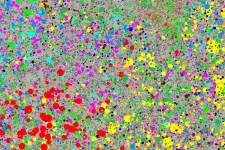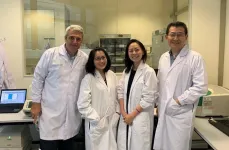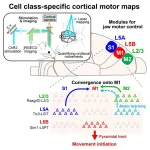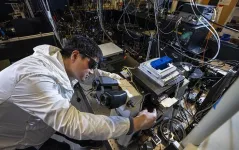(Press-News.org) Two papers published today in the journal Nature describe a significant advance in understanding the complex functions of the metabolic network. The research is from the lab of Marian Walhout, PhD, the Maroun Semaan Chair in Biomedical Research and chair and professor of systems biology, which has been engaged with fundamental questions of metabolism for more than a decade.
According to Dr. Walhout, organisms constantly monitor their nutrient intake and adjust their metabolism to generate biomass and energy; their metabolism takes place through a series of chemical reactions that together make up the metabolic network. The Walhout lab has sought to understand how these reactions work together and what happens when the normal flow of information within the network is disrupted. Do cells have the capacity to find alternate routes through the network? And how do they do this? The answers to these questions have broad implications as many diseases and health-related issues such as cancer, diabetes and obesity have root causes that stem from altered metabolism.
While single reactions and metabolic pathways have been studied in detail, it has been painstaking to determine which are active or ‘carry flux’ in a given cell, at a given moment. The first paper published today, “Systems-level design principles of metabolic rewiring in an animal” employs a systems approach to understanding the principles whereby the animal changes the flow of metabolism when metabolic reactions are disrupted. The second paper, “A systems-level, semi-quantitative landscape of metabolic flux in C. elegans,” uses data obtained from the first paper to infer the ‘natural’ wiring of the metabolic circuit in an animal, describing which reactions are active and which are turned off in a normal state.
Both studies were enabled by “Worm Perturb-Seq” (WPS), a novel high-throughput method used to deplete the expression of around 900 metabolic genes individually in C. elegans. WPS uses RNA sequencing to unveil how changes in different parts of the metabolic network (flux) affect gene expression and shows that gene expression can be used to learn how an organism deals with alterations in its metabolism. The data accrued from this systematic study revealed a high-level model where ‘core’ metabolic functions, when depleted, are compensated for by genes with the same core metabolic function while other core metabolic functions are repressed. What Walhout and colleagues have called a “compensation-repression,” or CR model, represents a strategy used by, in this case, the worm, to monitor the state of its metabolism and adjust it at the gene regulatory level. Fascinatingly, preliminary analysis of human data indicates that the CR model may also explain perturbations in human metabolism.
“When we analyzed the WPS data, it became clear that it was not only instrumental to understand how the animal rewires its metabolism through the compensation-repression model, but also that we could use the data to infer, by computational modeling, how the metabolic flux runs through the network, or is ‘wired,’ in the worm in its normal state,” said Walhout. “By transforming questions about metabolism into a genomics challenge, we were able to draw a ‘wiring map’ of adult worm metabolism that revealed numerous novel insights.”
“The most exciting part of the study for me was seeing that the majority of our predictions are validated through isotope tracing experiments,” said Hefei Zhang, PhD, a postdoctoral fellow and co-first author on both papers. “Those results indicated that our concept of using molecular phenotypes to predict metabolic network wiring at systems level is really reliable.”
Among these insights are the use of RNA as a carbon source by the organism; the use of amino acids as an energy source to fuel the tricarboxylic acid cycle; and surprisingly, that carbohydrates such as glucose, which had previously been assumed to be the major source for energy production, have a relatively minor contribution in the worm.
“WPS and the results presented in the two studies should provide a powerful framework for similar studies in other organisms, including humans, to provide insights into healthy metabolism, as well as different diseases where metabolism runs awry,” said Walhout.
Xuhang Li, a recently graduated student and co-first author on both papers added, “Together, these studies establish a new paradigm for studying metabolism throug
END
Two papers by Walhout lab in Nature highlight novel metabolic principles
Genomics approach to metabolism reveals how reactions flow
2025-02-26
ELSE PRESS RELEASES FROM THIS DATE:
Multiplexing entanglement in a quantum network
2025-02-26
Laying the groundwork for quantum communication systems of the future, engineers at Caltech have demonstrated the successful operation of a quantum network of two nodes, each containing multiple quantum bits, or qubits—the fundamental information-storing building blocks of quantum computers.
To achieve this, the researchers developed a new protocol for distributing quantum information in a parallel manner, effectively creating multiple channels for sending data, or multiplexing. The work was accomplished by embedding ytterbium atoms ...
Bacteria consumed by immune cells become part of the cell
2025-02-26
Immune cells that eat bacteria in the body don’t stash them in specialized compartments as once thought, but turn them into critical nutrients that build proteins, create energy and keep the cells alive, according to a new study from scientists at the University of Colorado Anschutz Medical Campus.
“We are what we eat,” said the study’s co-senior author Angelo D’Alessandro, Ph.D., professor of biochemistry and molecular genetics at the University of Colorado School of Medicine at CU Anschutz. “What we eat changes the composition of us and when immune cells eat bacteria the same thing happens to them.”
The ...
CSIC researchers discover how the brain builds sophisticated maps to navigate and remember the world
2025-02-26
The brain creates internal 'maps' to help us navigate and learn from our surroundings, but how these maps form remains a challenge to understand. Now, a study led by Liset M. de la Prida at the Cajal Neurosciences Center (CNC-CSIC) in Madrid, in collaboration with Imperial College London, offers a fresh perspective on how spatial and experiential information is encoded in the hippocampus, a key brain region for navigation and memory.
The study published today in Neuron, reveals that two types of hippocampal ...
New spatial mechanism for the coexistence of tree species
2025-02-26
The data sets are very large: with more than 75 permanent forest dynamics plots in 29 countries worldwide, the Forest Global Earth Observatory network (ForestGEO) of the Smithsonian Tropical Research Institute (STRI) provides excellent forest inventories for investigating the dynamics of forest ecosystems and better understanding the processes that drive the structure and function of forests. On these 20-to-50-hectare plots, every single tree with a diameter not much larger than a pencil has been identified, measured and mapped every five years, often totalling more than 200 000 trees. The two UFZ researchers, Dr. Thorsten Wiegand ...
City of Hope research features myeloma study, cancer surgery and more
2025-02-26
This roundup highlights a common drug that can help treat multiple myeloma, a paper analyzing the benefit of a colorectal surgery follow-up test, recommendations for implementing remote patient monitoring for care received before, during and after surgery, details on how often women with an elevated breast cancer risk are receiving enhanced screenings, and clinical trial results for a new chimeric antigen receptor (CAR) T cell therapy targeting B cell acute lymphoblastic leukemia.
To learn more about research at City of Hope, one of the largest and most advanced cancer research and treatment organizations in the U.S. with its ...
A*STAR spin-off NalaGenetics implements nationwide drug reaction screening for leprosy patients in Indonesia
2025-02-26
SINGAPORE – NalaGenetics, a spin-off from A*STAR Genome Institute of Singapore (A*STAR GIS), will be transforming leprosy treatments in Indonesia with a nationwide genetic screening programme with their PGx1301 diagnostic kit. Set to launch in the fourth quarter of 2025, this initiative builds on a successful five-year pilot test in East Indonesia, which demonstrated the effectiveness of precision medicine in preventing life-threatening adverse drug reactions (ADRs).
As part of this programme, up ...
Unraveling the brain’s hidden motor modules
2025-02-26
For nearly a century, scientists have known that different parts of the human brain’s cortex control different body movements. This fundamental discovery dates to the 1930s, when neurosurgeons used electrical stimulation to map how different cortical regions correspond to different body parts.
But can these regions be further broken down into even smaller functional components? Researchers have long suspected that cortical units for specific body movements are more complex than simple patches in the cortex. Studies have identified various types of neurons stacked in multiple layers across the neocortex, but without a clear picture of how these ...
New photon-avalanching nanoparticles could enable next-generation optical computers
2025-02-26
A research team co-led by Lawrence Berkeley National Laboratory (Berkeley Lab), Columbia University, and Universidad Autónoma de Madrid has developed a new optical computing material from photon avalanching nanoparticles.
The breakthrough – which the team published recently in the journal Nature Photonics – paves the way for fabricating optical memory and transistors on a nanometer size scale comparable to current microelectronics. This approach offers a path toward realizing smaller, faster components for next-generation ...
Current status and future perspectives on early detection and diagnosis of colorectal cancer in China
2025-02-26
Colorectal cancer (CRC) is the second most commonly diagnosed cancer in China and a leading cause of cancer-related mortality. Despite improvements in treatment, the survival rate remains lower than in Western and other Asian countries due to late-stage diagnosis. Given that CRC typically develops over a prolonged period from precursor lesions, early detection and timely intervention are crucial for improving patient outcomes. However, CRC screening in China faces several challenges, including regional disparities, economic constraints, and limited public awareness. Recent advancements in non-invasive diagnostic tests, innovative imaging techniques, and ...
Program’s expansion boosts student research opportunities
2025-02-26
Aerospace engineering senior Philip Wilson attended an American Institute of Aeronautics and Astronautics (AIAA) conference. Rohit Raut, a senior physics major, presented his work at a nuclear research symposium, and senior biology major Jaden Rankin had the opportunity to feature her research at an entomology conference.
These and other University of Texas at Arlington students were able to showcase their original research at major symposiums thanks to UTA’s expansion of its popular undergraduate research program that provides funding for select students to present at academic conferences.
“At the conference, I presented my work on rotating ...
LAST 30 PRESS RELEASES:
Making lighter work of calculating fluid and heat flow
Normalizing blood sugar can halve heart attack risk
Lowering blood sugar cuts heart attack risk in people with prediabetes
Study links genetic variants to risk of blinding eye disease in premature infants
Non-opioid ‘pain sponge’ therapy halts cartilage degeneration and relieves chronic pain
AI can pick up cultural values by mimicking how kids learn
China’s ecological redlines offer fast track to 30 x 30 global conservation goal
Invisible indoor threats: emerging household contaminants and their growing risks to human health
Adding antibody treatment to chemo boosts outcomes for children with rare cancer
Germline pathogenic variants among women without a history of breast cancer
Tanning beds triple melanoma risk, potentially causing broad DNA damage
Unique bond identified as key to viral infection speed
Indoor tanning makes youthful skin much older on a genetic level
Mouse model sheds new light on the causes and potential solutions to human GI problems linked to muscular dystrophy
The Journal of Nuclear Medicine ahead-of-print tip sheet: December 12, 2025
Smarter tools for peering into the microscopic world
Applications open for funding to conduct research in the Kinsey Institute archives
Global measure underestimates the severity of food insecurity
Child survivors of critical illness are missing out on timely follow up care
Risk-based vs annual breast cancer screening / the WISDOM randomized clinical trial
University of Toronto launches Electric Vehicle Innovation Ontario to accelerate advanced EV technologies and build Canada’s innovation advantage
Early relapse predicts poor outcomes in aggressive blood cancer
American College of Lifestyle Medicine applauds two CMS models aligned with lifestyle medicine practice and reimbursement
Clinical trial finds cannabis use not a barrier to quitting nicotine vaping
Supplemental nutrition assistance program policies and food insecurity
Switching immune cells to “night mode” could limit damage after a heart attack, study suggests
URI-based Global RIghts Project report spotlights continued troubling trends in worldwide inhumane treatment
Neutrophils are less aggressive at night, explaining why nighttime heart attacks cause less damage than daytime events
Menopausal hormone therapy may not pose breast cancer risk for women with BRCA mutations
Mobile health tool may improve quality of life for adolescent and young adult breast cancer survivors
[Press-News.org] Two papers by Walhout lab in Nature highlight novel metabolic principlesGenomics approach to metabolism reveals how reactions flow






